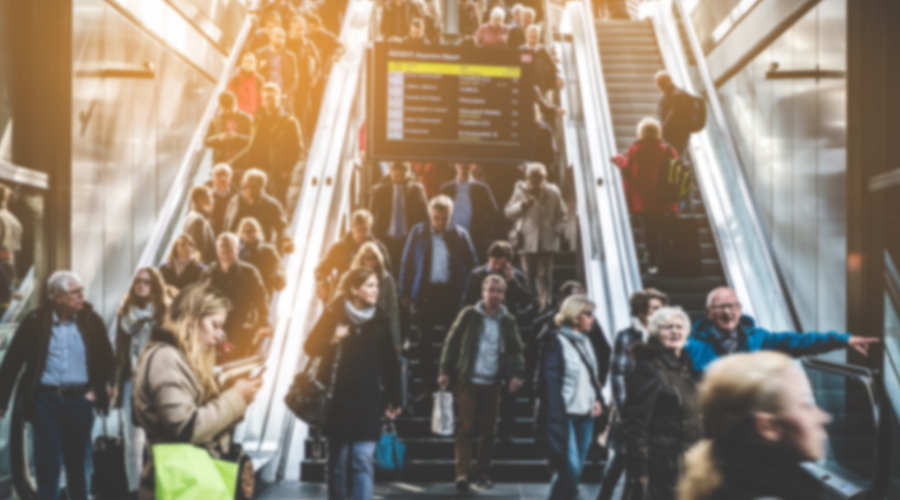Top 3 Reasons Airports and Transport Hubs are Adopting Video Content Analytics

Reassuring Travelers and Recouping Revenue
As the COVID-19 pandemic wanes, airports re getting busy again, but 2020 and early 2021 hit the transportation sector hard financially. To ramp up to pre-pandemic levels of ridership, operators are focusing on reassuring passengers and visitors that they can be confident in the health and safety standards of the transport hub. Beyond this, airports are assessing how they can be more efficient, not only to reduce their own costs, but also to drive revenue and passenger satisfaction. There are three key areas where transport hub operators can focus their efforts: streamlining traffic flows throughout terminals and hubs, maximizing the traveler experience and airport revenues with attractive retail and restaurant tenants within terminals, and optimizing sanitation and health safety practices to boost traveler confidence in the safety and cleanliness of the facilities.
For most, these improvements can be made through changes in business processes and investments in supporting technologies. A good starting place for many transport operators is considering ways to optimize current existing technologies, such as video surveillance (CCTV) networks, to realize even more value. Airports and transport terminals can leverage video analytics software to maximize the potential of their video surveillance systems and drive efficiencies across several departments, including traveler experience, operational planning, and security.
What is Video Analytics?
Powered by Artificial Intelligence in the form of Deep Learning, video analytics software identifies, classifies and indexes objects in surveillance video; the extracted and categorized data becomes searchable, actionable and quantifiable and can be used for video search, alerting and data visualization based on extensive filter combinations. By processing video in real-time and on-demand, users can benefit from increased situational awareness as well as long term insights into their environment.
Measure Traffic Volume and Optimize Traffic Flow
Accurate vehicle and pedestrian traffic data is one of the most important metrics for operations, planning and service managers. Video analytics data visualizations and real-time alerts can be used to track the number of people or vehicles that pass through any given area, on an hourly, daily or weekly basis, so that aviation and transit authority planners can make more informed decisions to mitigate public safety risks, crowding, and bottlenecks.
Video analytics can be used to differentiate between types of vehicles, such as buses, vans, and private vehicles, so that vehicle activity in departure and arrival drop-off zones, taxi lanes and car parks, can be monitored. An operator may choose to track vehicle dwelling patterns to understand trends for vehicles that loiter in a drop-off or pickup lane; such insights can inform strategies to prevent that loitering behavior in the future. Similarly, a video analytics system can uncover trends regarding pedestrian crowding in various areas of a terminal, so staffing and signage can be optimized to more effectively prevent crowding problems and keep travelers moving.
Security and operations managers can also use video analytics to improve awareness of evolving situations by configuring rule-based, real-time alerts that notify operators of situations such as a crowd forming, to proactively prevent bottlenecks and long queues in areas such as security gates, check-in points, ticketing counters, waiting areas, and taxi lines.
Develop Business to Enhance Traveler Experiences
Knowing the pedestrian volume of traffic in each area of a terminal is also crucial to utilizing space effectively. By analyzing footfall insights for commercial analysis, transit hub management teams can understand how visitors tend to reach different stores or restaurants, uncover how they interact with ad kiosks and quantify how many unique visitors pass by or enter a tenant site. For the airport or transport hub, this gained business intelligence can guide tenancy sales and pricing. This enables them to quantify the value of a particular terminal rental space and decide based on rich traffic and demographic data which attractions or amenities will most positively impact the traveler experience.
Monitor Compliance with Health Safety Measures
To help travelers feel confident that it is safe to travel again, transportation managers must demonstrate that they are monitoring compliance with health safety protocols, such as social distancing and mask wearing. According to Airport World magazine, a recent survey by IT provider SITA “…revealed that 87% of airports confirmed that programs to address passenger health and safety protocols have either been implemented or are planned. These are said to include sensors, video monitoring and robots to automatically monitor passenger social distancing, temperature checks, sanitization, and other health criteria.”
With the ability to detect face masks and track physical proximity between individuals, video analytics empowers operators to review dashboard reports that illustrate where and how often physical distancing and mask mandates are adhered to. This can help identify when and where violations tend to occur. If necessary, custom alerting can be configured to trigger real-time notifications of violations and allow for proactive and swift response, to ensure the safety of the traveler is upheld. for example, extra exit lanes opening to better assist with distancing and pedestrian flow.
Beyond enforcing new health and safety requirements, now more than ever airports and transit terminals must be able to effectively clean and maintain heavily trafficked spaces. Maintenance departments can leverage video analytics data to track facilities usage, so they can schedule cleaning according to actual data and deploy staff more effectively. Operators can even receive real-time occupancy alerts or when a threshold of people have entered an area, such as a restroom area or a food court. With the ability to derive insight from video, airports and transit hubs will be able to promote compliance and maintenance stats, assure prospective travelers, and motivate current travelers to continue traveling.
By turning to video content analytics, transportation operators can tap into the valuable information that lies buried in their video footage. This includes optimizing traffic flows, quantifying the value of tenant spaces, improving maintenance, and complying with evolving health mandates, all of which will facilitate traveler satisfaction, comfort, and confidence.
Signup to receive a monthly blog digest.